Spaghetti Aglio e Olio
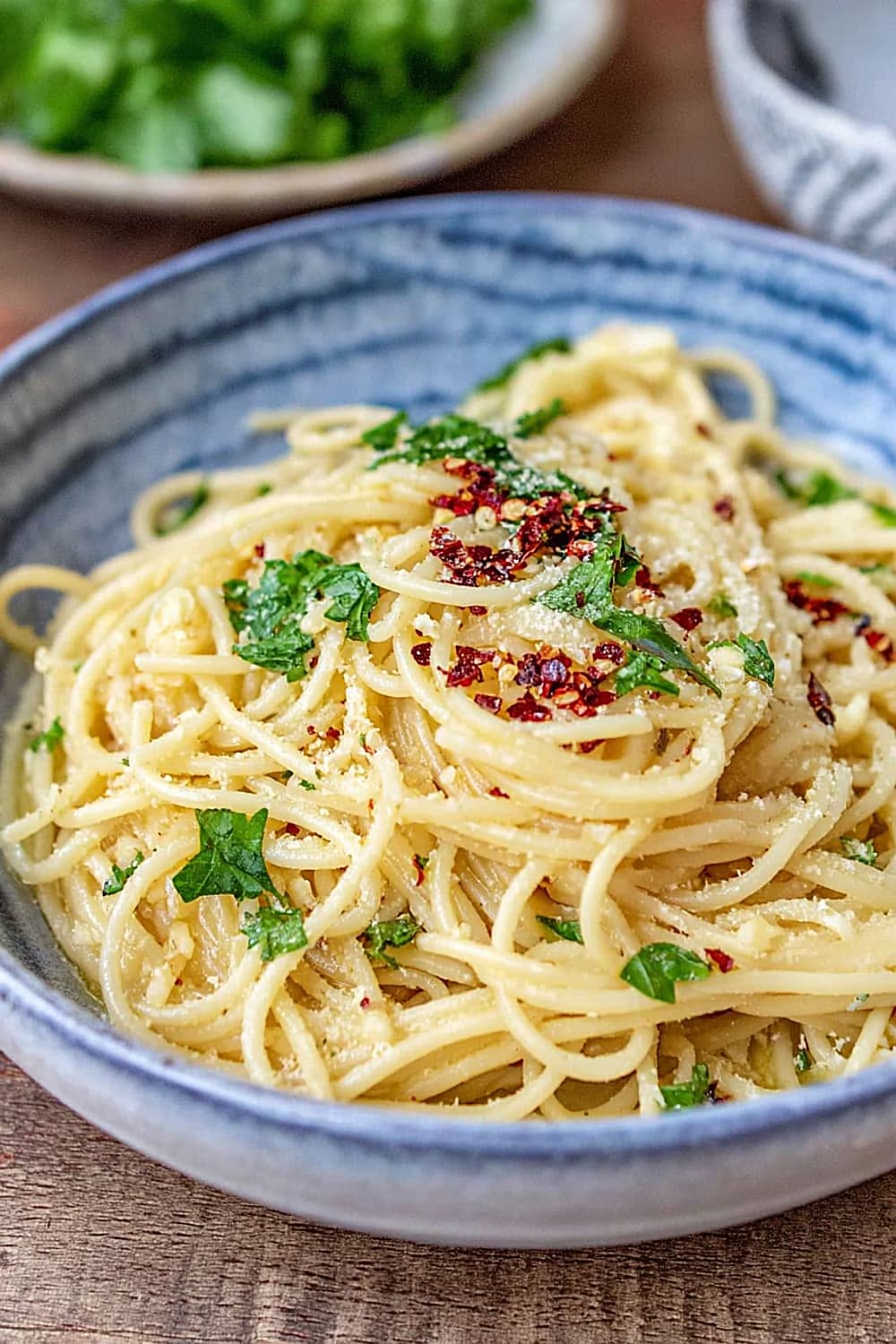
This is the kind of pasta that makes you look like a culinary genius when you’re really just following a ridiculously simple formula that Italians have perfected over centuries.
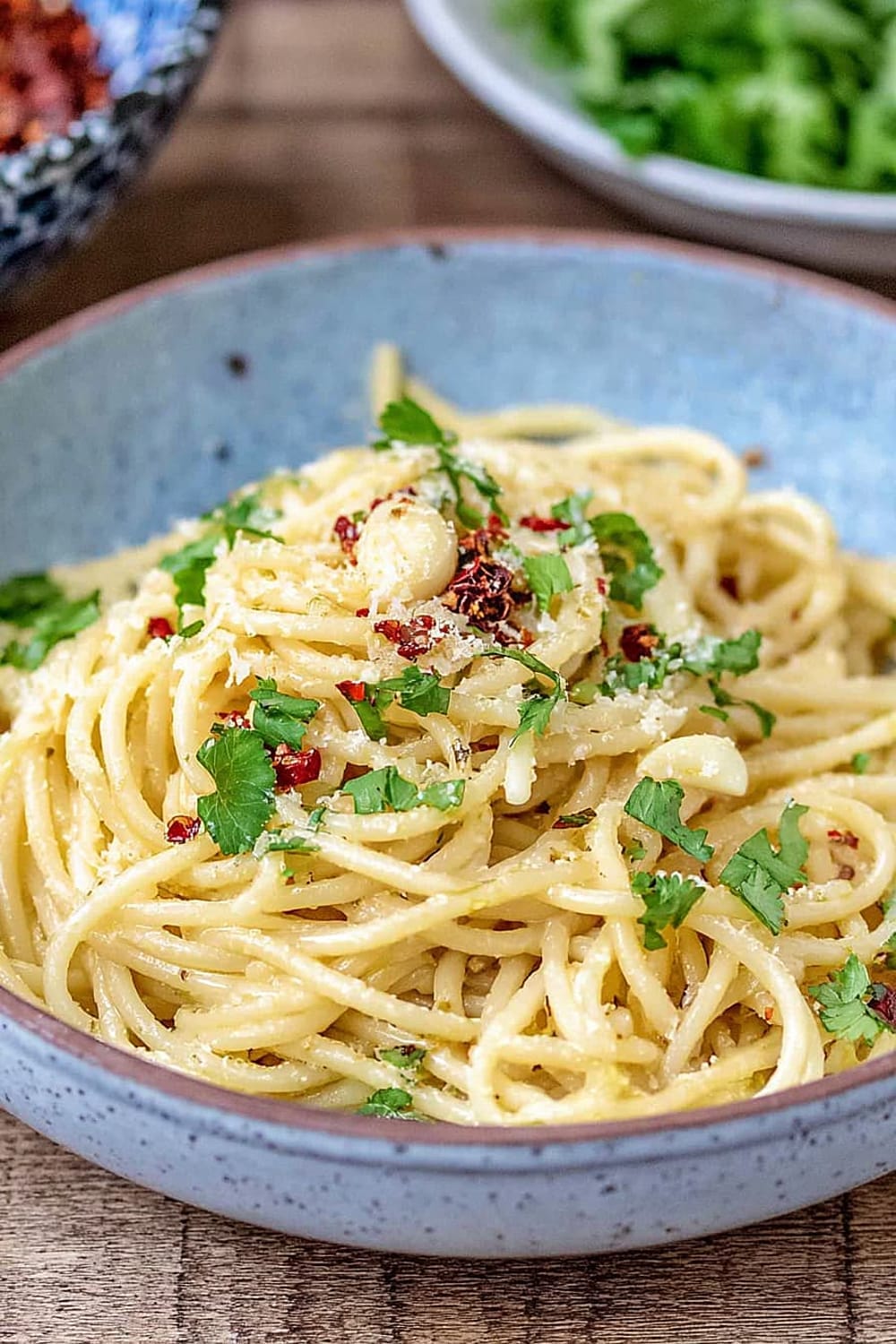
Six ingredients, twenty minutes, and zero stress-induced kitchen breakdowns – this recipe is basically the cooking equivalent of finding money in your old jeans pocket.
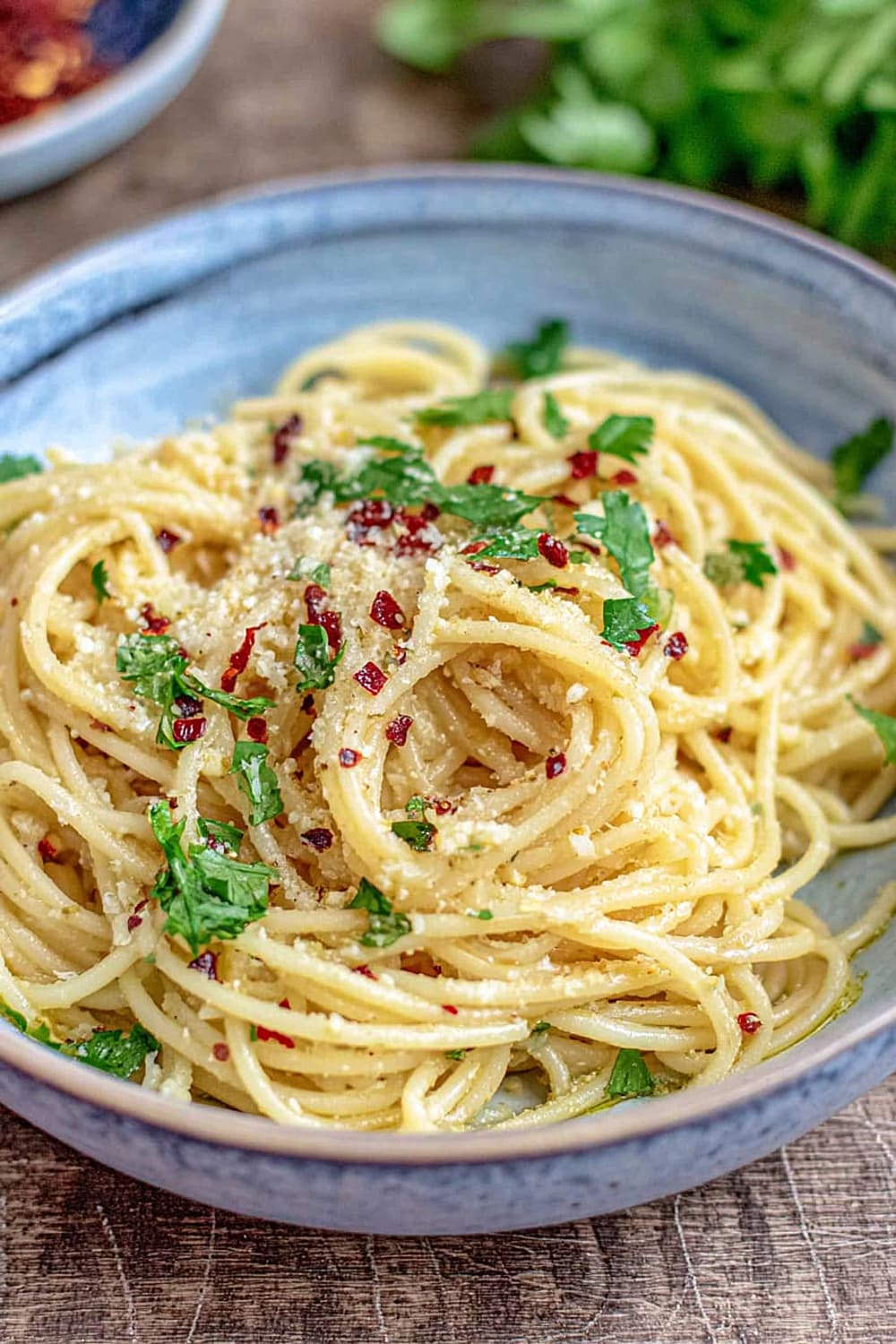
The magic happens when golden garlic meets silky olive oil and transforms into this glossy, aromatic sauce that clings to every strand of perfectly al dente spaghetti.
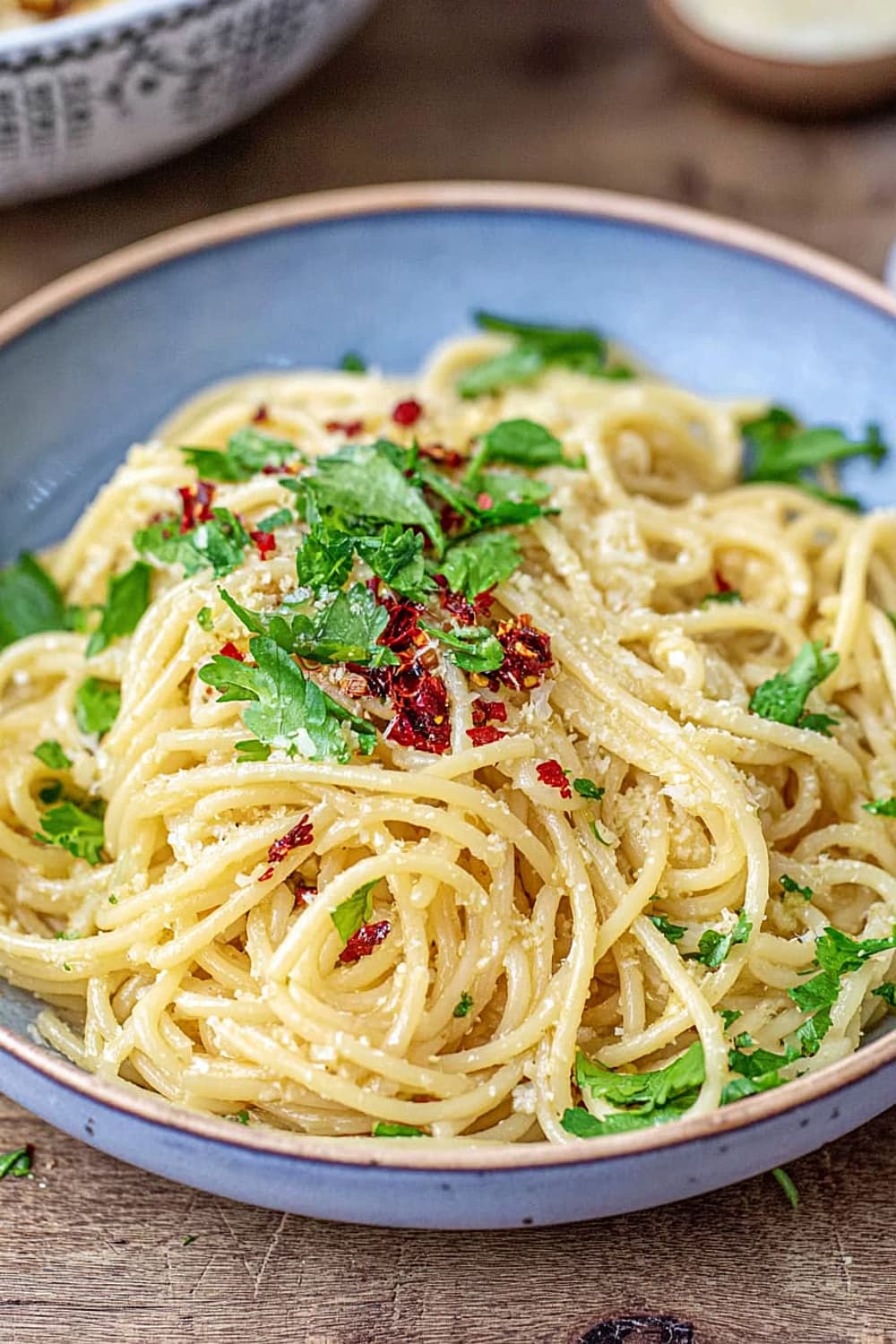
You’ll be amazed how something so minimalist can taste so incredibly sophisticated – it’s like the little black dress of pasta dishes.

The best part is watching people take that first bite and get that slightly stunned expression that says “Wait, this is just garlic and oil?”
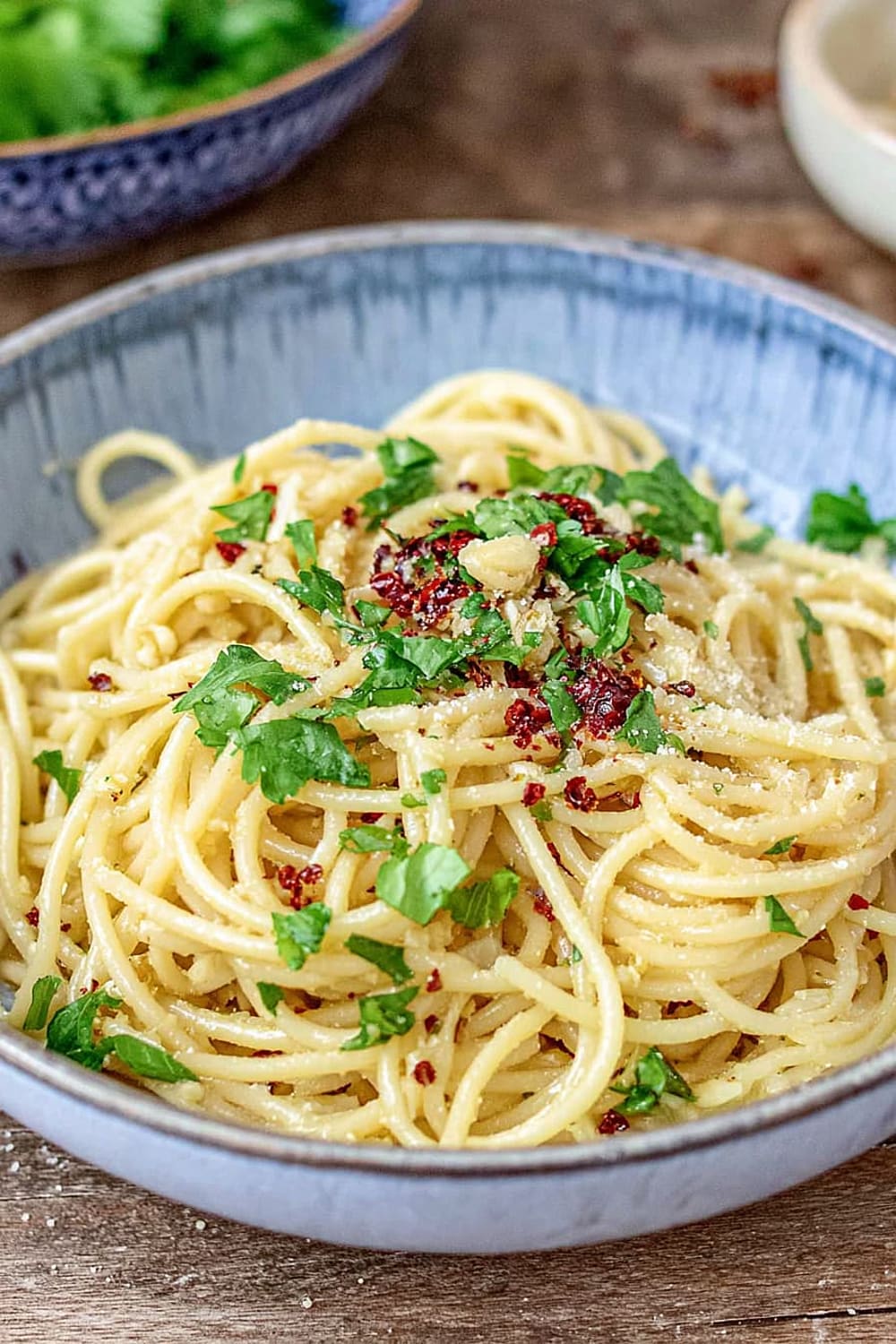
Prepare yourself for requests to make this every single time you have dinner guests, because once people taste authentic aglio e olio, they become completely obsessed.
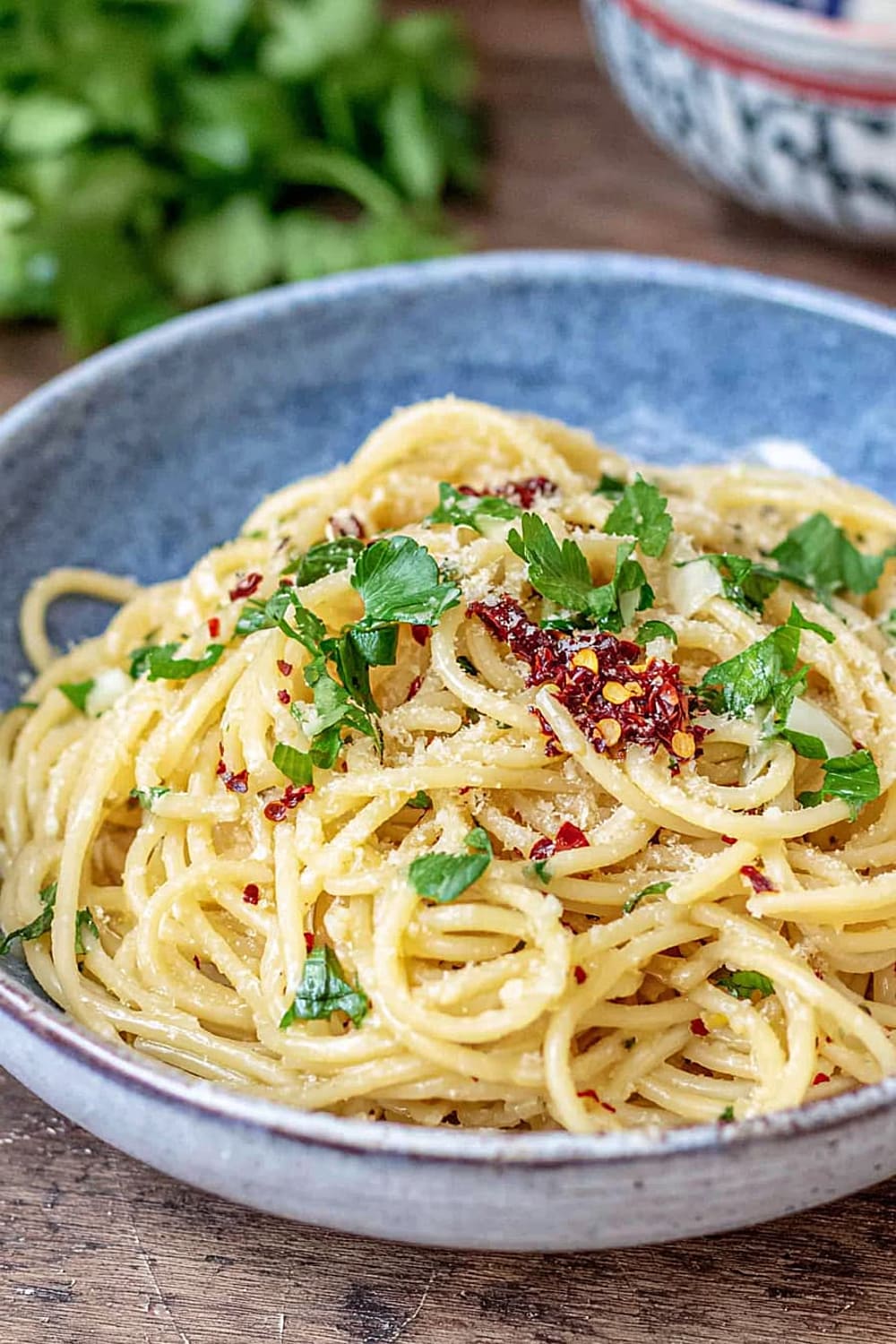
Ingredients
For the pasta
- 12 ounces spaghetti
- Kosher salt for pasta water
For the aglio e olio sauce
- 1 /2 cup extra virgin olive oil (use the good stuff here)
- 8 garlic cloves, thinly sliced
- 1 /2 teaspoon red pepper flakes (optional, adjust to taste)
For finishing
- 1 /3 cup grated parmesan cheese (optional)
- Fresh parsley, chopped for garnish
Instructions
Prepare the pasta
- 1 Bring a large pot of water to a rolling boil and salt the water generously with about 1 tablespoon kosher salt – it should taste like seawater. This is crucial because the pasta water will become part of your sauce, and under-salted pasta water means bland pasta.
- 2 Add the 12 ounces spaghetti to the boiling water and cook according to package directions until just before al dente, typically about 9 minutes. You want it slightly firmer than you’d normally eat it because it will finish cooking in the sauce.
- 3 Before draining the pasta, reserve 1 1/2 cups of the starchy pasta cooking water using a liquid measuring cup or ladle. This starchy water is liquid gold for creating a silky sauce that clings to the pasta.
Create the garlic oil
- 4 About 4 minutes after adding the pasta to the boiling water, heat the 1/2 cup extra virgin olive oil in a large skillet or sauté pan over medium heat. Using a cast iron skillet here gives you excellent heat control and prevents hot spots that could burn the garlic.
- 5 Add the 8 sliced garlic cloves to the warm oil and stir constantly with a wooden spoon or silicone spatula until they just begin to turn golden brown, about 2-3 minutes. Watch carefully – garlic goes from perfect to burnt in seconds, so reduce heat if needed.
- 6 When the garlic reaches that perfect golden color, add the 1/2 teaspoon red pepper flakes (if using) and toss for 30 seconds. If your pasta isn’t ready yet, remove the pan from heat to prevent overcooking.
Bring it all together
- 7 Return the pan to medium heat (if you removed it) and carefully whisk in 1 cup of the reserved pasta water. The mixture will bubble and steam – this is normal. Let it simmer until the liquid reduces by about 1/3, creating a glossy emulsion.
- 8 Add the drained pasta directly to the skillet and toss vigorously using tongs to coat every strand in the garlicky oil. If the mixture seems dry, add more pasta water 2 tablespoons at a time until you achieve a silky consistency.
- 9 Remove from heat and add the grated parmesan and chopped parsley (if using). Toss once more to combine, adding a final splash of pasta water if needed to maintain that glossy finish.
- 10 Let the pasta rest for 2-3 minutes to absorb the sauce before serving. Serve immediately with additional parmesan and red pepper flakes on the side.
Recommended Equipment and Kitchen Tools
Essential Tools (for best results)
- Large pasta pot – A 6-8 quart pot ensures pasta cooks evenly without sticking
- Large skillet or sauté pan – Cast iron skillet provides excellent heat control for the delicate garlic
- Sharp knife – Essential for achieving paper-thin garlic slices that cook evenly
- Tongs – The best tool for tossing pasta with sauce and achieving that perfect coating
Helpful Upgrades
- Microplane grater – Creates fluffy, restaurant-quality parmesan that melts beautifully into the sauce
- Digital kitchen scale – Measuring pasta by weight ensures consistent results every time
- Silicone spatula – Won’t scratch your pans and provides gentle stirring for the garlic
- Liquid measuring cup – Makes reserving pasta water much easier than using a ladle
Nice-to-Have Options
- Pasta fork – Traditional tool for lifting and serving long pasta strands elegantly
- Fine-mesh strainer – Allows you to drain pasta while keeping the pot for pasta water storage
- Wooden spoon – Traditional choice for stirring that won’t conduct heat or damage cookware
Recipe Variations and Dietary Modifications
Gluten-Free Adaptation
- Substitute with 12 ounces gluten-free spaghetti (brands like Barilla or Jovial work well)
- Cook for 1-2 minutes longer than package directions as gluten-free pasta can be more delicate
- Reserve extra pasta water as gluten-free noodles may need more liquid for sauce consistency
- Expect a slightly different texture but equally delicious results
Protein Additions
- Grilled shrimp – Add cooked shrimp in the last minute of tossing
- Italian sausage – Brown crumbled sausage before adding garlic to the same pan
- Pancetta – Crisp diced pancetta first, then use the rendered fat as part of your oil measurement
- White beans – Fold in cannellini beans for a heartier, more substantial meal
Vegetable Variations
- Broccoli rabe – Blanch and add during the final toss for authentic Italian preparation
- Cherry tomatoes – Halve and add with red pepper flakes for bursts of sweetness
- Spinach – Wilt fresh spinach into the hot pasta for added nutrition and color
- Roasted red peppers – Slice and add for smoky sweetness and beautiful color contrast
Flavor Enhancements
- Lemon zest – Add fresh lemon zest with the parsley for bright, citrusy notes
- Anchovy paste – Dissolve 1 teaspoon into the oil for authentic umami depth
- Fresh herbs – Try basil, oregano, or thyme instead of parsley for different flavor profiles
Nutritional Information and Health Benefits
Key Nutritional Highlights
Each serving provides approximately 380 calories with a balanced combination of complex carbohydrates from the pasta and healthy monounsaturated fats from the extra virgin olive oil. The dish offers about 12 grams protein per serving, with 6 grams fiber from the pasta. The olive oil contributes beneficial vitamin E and antioxidants, while garlic provides allicin compounds known for their anti-inflammatory properties.
Health Benefits of Main Ingredients
The extra virgin olive oil is rich in oleic acid and polyphenols, which support heart health and may help reduce inflammation throughout the body. Fresh garlic contains allicin, a sulfur compound that may help boost immune function and support cardiovascular health. The pasta provides sustained energy through complex carbohydrates and contains B vitamins essential for energy metabolism. Red pepper flakes contain capsaicin, which may boost metabolism and provide antioxidant benefits.
Dietary Considerations
This recipe is naturally vegetarian and can easily be made vegan by omitting the parmesan cheese. It contains gluten from wheat pasta and is dairy-free without the optional cheese. The dish is relatively low in sodium when you control the salt added to pasta water. Each serving provides a good balance of macronutrients, making it suitable for active individuals seeking sustained energy from whole food sources.
Smart Swaps and Ingredient Substitutions
Oil Alternatives:
- Extra virgin olive oil → Avocado oil (neutral flavor, higher smoke point)
- Olive oil → Garlic-infused olive oil (double the garlic flavor intensity)
- Regular olive oil → Cold-pressed olive oil (better flavor and nutritional profile)
Pasta Substitutions:
- Spaghetti → Linguine or angel hair (similar cooking method, slightly different texture)
- Regular pasta → Whole wheat spaghetti (nuttier flavor, more fiber)
- Wheat pasta → Chickpea or lentil pasta (higher protein, gluten-free option)
Garlic Alternatives:
- Fresh garlic cloves → Garlic powder (use 1 teaspoon, less aromatic but works)
- Sliced garlic → Minced garlic (more intense flavor, easier to burn)
- Regular garlic → Roasted garlic (sweeter, milder flavor profile)
Budget-Friendly Swaps:
- Parmesan cheese → Pecorino Romano (sharper flavor, often less expensive)
- Fresh parsley → Dried parsley (use 1 tablespoon, less vibrant color)
- Premium olive oil → Mid-range extra virgin (still flavorful but more affordable)
Pro Tips for Substitutions:
- When using dried herbs instead of fresh, add them earlier in the cooking process
- Adjust cooking times when using different pasta shapes – thinner pastas cook faster
- Always taste and adjust seasoning when making substitutions
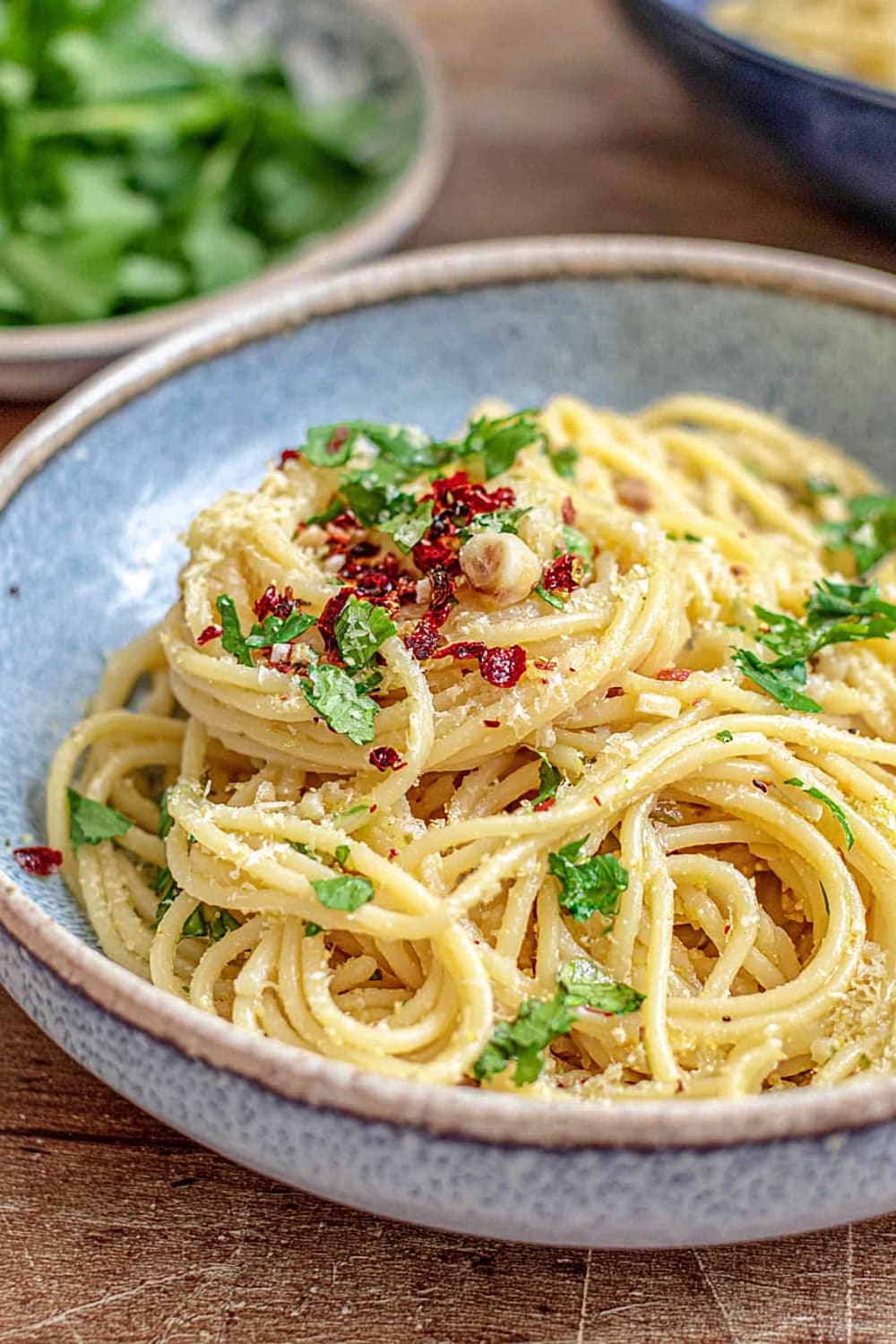
Make It Diabetes-Friendly
Carb Reduction Strategies:
- Replace regular pasta → Shirataki noodles or zucchini noodles (reduces carbs from 45g to 5-10g per serving)
- Use half pasta, half spiralized vegetables → Maintains familiar texture while cutting carbs by approximately 50%
- Choose whole grain pasta → Provides more fiber and protein, helping slow glucose absorption
Portion Control Modifications:
- Reduce pasta portion → Use 8 ounces pasta instead of 12, increase vegetables to maintain volume
- Estimated carbs per modified serving → Approximately 30g instead of 45g
- Add protein → Include grilled chicken or shrimp to help stabilize blood sugar response
Blood Sugar Management Tips:
- Pair with fiber-rich vegetables → Add sautéed broccoli or spinach to increase fiber content
- Include healthy fats → The olive oil helps slow carbohydrate absorption
- Timing matters → Serve as part of a balanced meal rather than alone
Enhanced Nutritional Profile:
- Add nuts → Pine nuts or walnuts provide protein and healthy fats
- Include lean protein → Helps create a more balanced macronutrient profile
- Boost vegetables → Cherry tomatoes and arugula add nutrients without significant carbs
Total Carb Reduction: Modified version contains approximately 30-35g carbs per serving versus 45g in the original recipe.
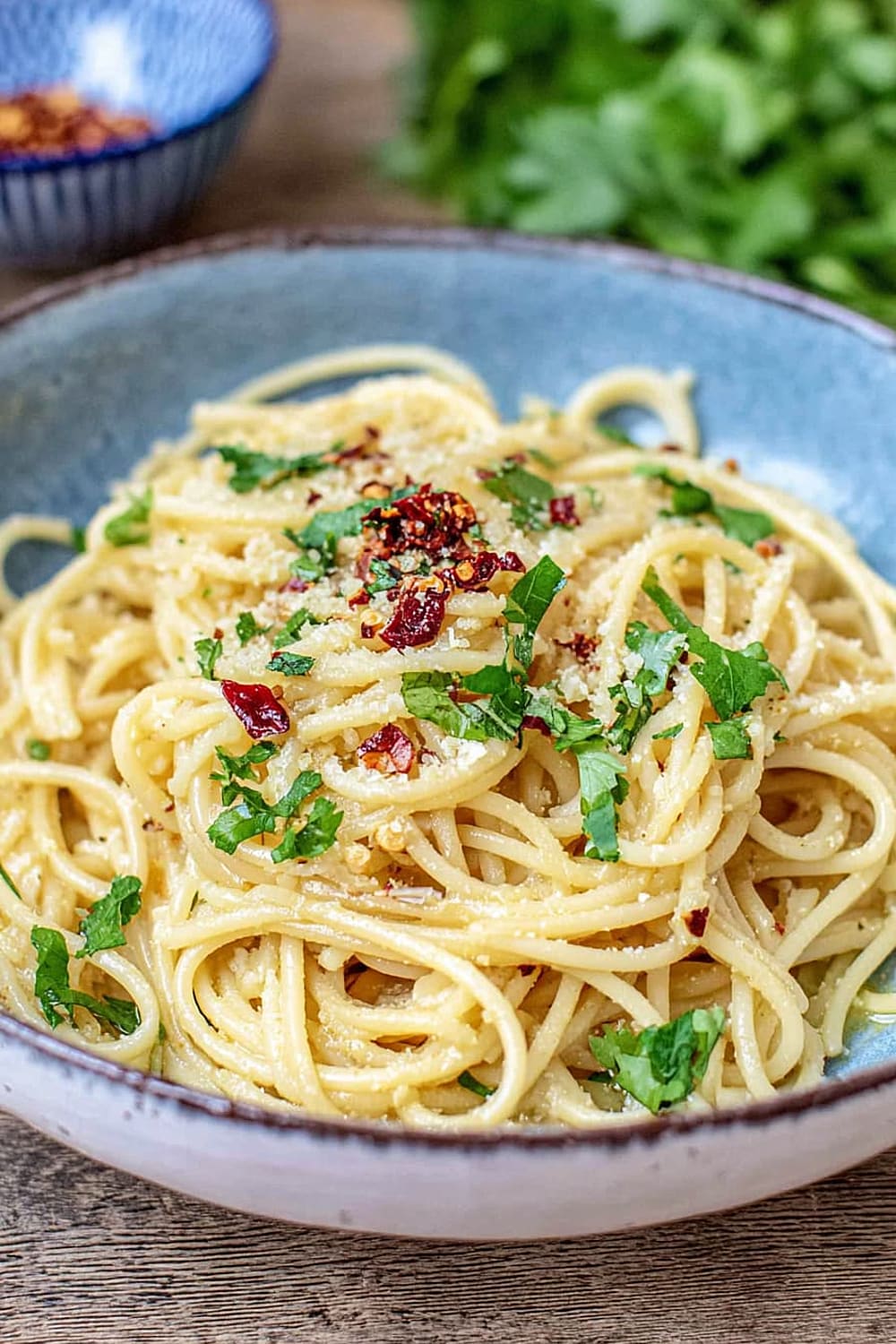
Perfect Pairing Suggestions
Wine Pairings
A crisp Pinot Grigio or Sauvignon Blanc complements the garlic and olive oil beautifully without overwhelming the delicate flavors. For red wine lovers, try a light Chianti Classico or Barbera d’Alba – their acidity cuts through the richness while enhancing the Italian character. Prosecco makes an excellent celebratory pairing, with its bubbles cleansing the palate between bites.
Side Dish Recommendations
Serve alongside a simple arugula salad dressed with lemon vinaigrette to provide peppery contrast to the rich pasta. Garlic bread might seem redundant, but a crusty Italian bread brushed with olive oil is perfect for sopping up any remaining sauce. Roasted vegetables like zucchini, bell peppers, or cherry tomatoes add color and nutrition while maintaining the Mediterranean theme.
Complete Meal Ideas
Start with antipasto featuring olives, fresh mozzarella, and prosciutto to set the Italian mood. For dessert, keep it light with fresh berries and a drizzle of balsamic reduction, or go traditional with tiramisu if you want something more indulgent. A simple caprese salad as an appetizer provides fresh contrast to the warm, garlicky pasta.
Occasion Suggestions
This recipe shines as a weeknight dinner when you want something special without the fuss, or as a romantic date night meal that feels intimate and sophisticated. It’s perfect for casual entertaining because you can make it start to finish while chatting with guests, and elegant enough for holiday meals when served as a first course.
Pro Tips and Troubleshooting
Professional Techniques
The key to restaurant-quality aglio e olio lies in the pasta water emulsion – vigorously tossing the pasta with the garlic oil and starchy pasta water creates a silky sauce that clings to every strand. Timing is everything: start your garlic oil when the pasta has about 4 minutes left to cook, ensuring both components finish simultaneously. Use tongs to lift and drop the pasta repeatedly while tossing – this motion helps create the perfect sauce consistency.
Common Mistakes and Solutions
Burnt garlic is the most frequent disaster – if your garlic turns dark brown, start over because bitter garlic will ruin the entire dish. Dry pasta happens when you don’t reserve enough pasta water or don’t add it gradually. Greasy results occur when the oil doesn’t emulsify properly with the pasta water – vigorous tossing is essential for creating that creamy consistency without cream.
Storage and Reheating
This pasta is best enjoyed immediately, but leftovers can be stored in the refrigerator for 2-3 days. Reheat gently in a skillet with a splash of water or broth rather than microwaving, which can make the pasta gummy. Add a drizzle of fresh olive oil and perhaps some fresh garlic to revive the flavors.
Make-Ahead Strategies
You can slice the garlic and measure out ingredients earlier in the day, but this dish must be cooked fresh for optimal results. The entire process takes only 20 minutes, making it perfect for spontaneous meals.
This deceptively simple pasta proves that the best Italian cooking isn’t about complicated techniques or exotic ingredients – it’s about treating a few perfect ingredients with respect and letting their natural flavors shine. Master this technique, and you’ll have a go-to recipe that never fails to impress, whether you’re cooking for yourself on a Tuesday night or hosting friends for an impromptu dinner party.